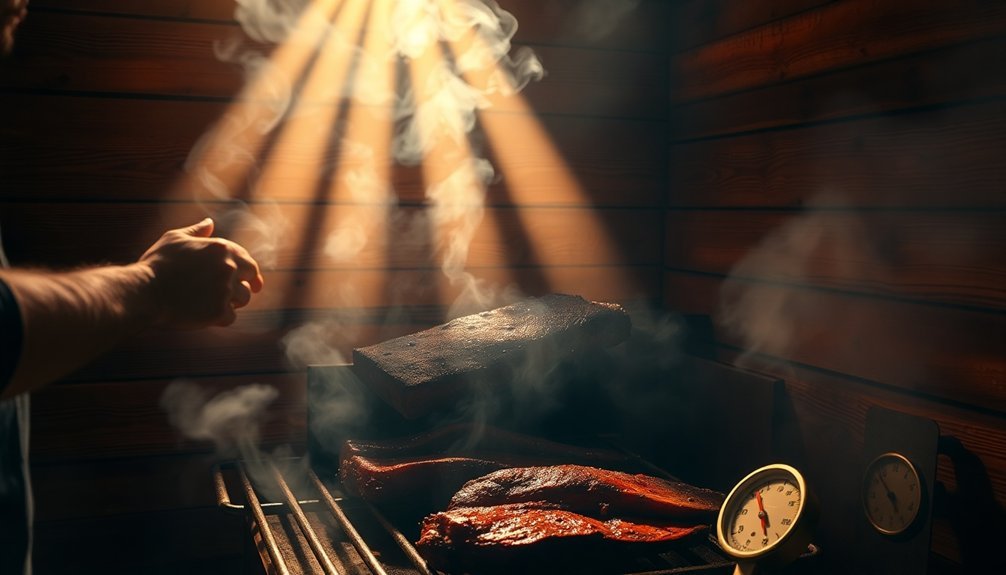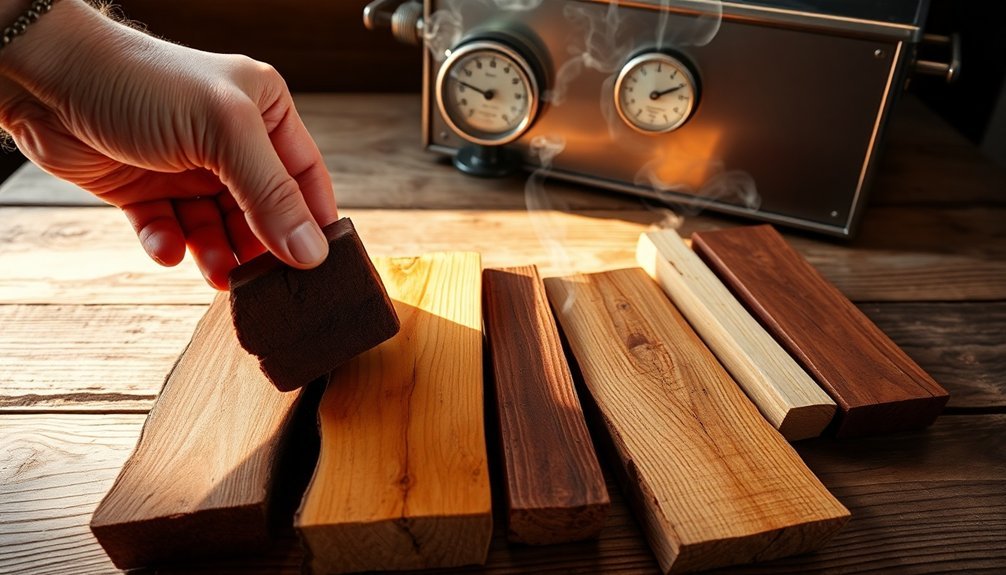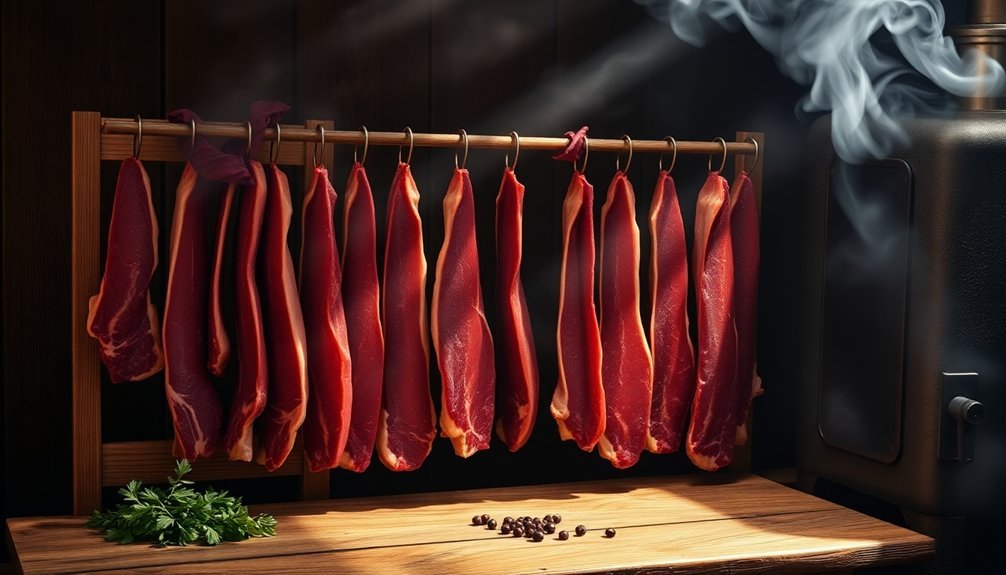Smoking meat like ancient food masters connects you to time-tested wisdom while creating incredibly flavorful dishes. You'll tap into traditional techniques that have preserved food for generations, from simple bamboo racks to earthen pit smokers. These methods don't just enhance taste – they infuse your meat with beneficial compounds and natural preservatives while breaking down tough fibers into tender, juicy results. Whether you're using hickory for bold barbecue or apple wood for delicate poultry, you'll discover why every culture worldwide has embraced smoke's transformative power. Ancient smoking wisdom holds secrets that modern pitmasters are still uncovering today.
Time-Tested Smoking Wisdom

Smoke wisdom passed down through generations reveals the timeless art of cooking with wood smoke. You'll find that traditional smoking methods, from bamboo racks to mud ovens, have stood the test of time because they work. These age-old techniques focus on the fundamentals: proper heat control, smoke management, and patience.
You don't need fancy equipment to smoke meat effectively. Ancient food masters used simple trench methods and two-box systems to achieve remarkable results. They understood that moving smoke prevents bitter flavors and guarantees even distribution across the meat. Using a water pan helps maintain moisture and creates a stable smoking environment.
When you're smoking, remember that different woods create distinct flavors, and choosing the right type of wood – whether chips, pellets, or chunks – matters for your specific smoking session.
The low-and-slow approach isn't just tradition; it's science. You'll notice that slow cooking breaks down tough collagen into gelatin, creating tender, succulent meat. When you maintain steady temperatures and clean smoke, you're following time-tested principles that guarantee ideal flavor penetration and texture.
For the best results, avoid lighter fluid and use natural fire starters like chimney starters to keep your smoke pure and clean.
Ancient Preservation Meets Modern Kitchen
The ancient practice of smoking meat bridges thousands of years of culinary history with today's modern kitchen techniques. You'll find that age-old preservation methods have evolved into sophisticated cooking approaches that maintain food safety while enhancing flavor profiles. Salt preservation techniques were often combined with smoking to create even more effective results.
| Ancient Method | Modern Adaptation |
|---|---|
| Open fire pits | Electric and gas smokers with temperature control |
| Natural wood smoke | Specific wood chips selected for distinct flavors |
| Communal smokehouses | Compact home smoking units |
Today's smoking techniques combine traditional wisdom with modern convenience. You don't need a dedicated smokehouse like your ancestors – instead, you can choose from various smoker types that fit your space and cooking style. While ancient cultures used smoking primarily for preservation, you can now focus on developing complex flavor profiles by experimenting with different woods, herbs, and marinades.
Modern food safety standards have refined these ancient techniques. You'll want to maintain precise temperature control and humidity levels, something your ancestors couldn't do. Yet, the fundamental principles remain unchanged: the smoke still contains natural preservatives like phenols and creosote that enhance shelf life while creating that distinctive smoky flavor you crave.
Choosing Your Smoking Woods

From subtle to robust, selecting the right smoking wood dramatically influences your meat's final flavor profile.
You'll find that hickory delivers an intense, smoky taste perfect for pork and ribs, while oak offers a versatile medium flavor that works well with everything from brisket to chicken.
For milder options, maple wood imparts a sweet touch ideal for bacon and poultry, while fruit woods like apple and cherry create gentle, sweet notes that complement game meats. Cedar planks are excellent for cooking salmon.
Your choice of wood form matters just as much as the type. If you're planning a long smoke session, logs or chunks will provide sustained flavor, while chips work better for shorter cooks or when you need a quick boost of smoke.
Pellets offer consistency in pellet grills, and planks serve well for hot, fast cooking.
Remember to stick with hardwoods and avoid softwoods like pine, which can produce harmful smoke.
You'll want to soak your chips or chunks in water before use to prevent quick burning and create more smoke.
As you experiment with different woods and forms, you'll discover the combinations that best suit your smoking style and taste preferences.
Temperature and Timing Mastery
Mastering temperature control and timing stands as the cornerstone of successful meat smoking. You'll need to maintain temperatures between 225°F and 250°F for most meats while monitoring both your smoker's air temperature and the meat's internal temperature to guarantee food safety and peak tenderness.
| Meat Type | Target Temperature | Cooking Time |
|---|---|---|
| Brisket | 195-205°F | 1 hr/pound at 250°F |
| Pork Butt | 205°F | 1 hr/pound at 250°F |
| Chicken | 165°F | 4 hrs whole, 1.5 hrs thighs |
To achieve the best results, you'll want to keep your meat in the critical collagen breakdown zone (160°F-205°F) for the right duration. Start with cold meat from the fridge to maximize smoke absorption through thermophoresis. You can enhance moisture retention by using a water pan and employing techniques like spritzing with water, vinegar, or apple juice. Remember that smoking times aren't set in stone – they're estimates that vary based on meat size and desired texture. For instance, a whole turkey smokes at about 30 minutes per pound, while ribs might take 5-6 hours total. Always let your meat rest after smoking to complete the tenderizing process.
Health Benefits Through History

Beyond temperature control lies a rich heritage of health benefits that spans centuries of meat smoking practices. When you smoke meat, you're tapping into an ancient preservation method that naturally inhibits bacteria and fungi while creating a protective acidic coating on the meat's surface.
You'll find that smoking offers more than just preservation. The process infuses your meat with beneficial antioxidant compounds from the wood smoke, helping protect your body against free radicals and chronic diseases.
The slow, low-temperature smoking technique also reduces the formation of harmful compounds typically associated with high-heat cooking methods. What you're getting is a nutrient-dense food that's rich in high-quality protein and essential vitamins and minerals.
If you're smoking fish, you'll benefit from heart-healthy Omega-3 fatty acids. The smoking process naturally dehydrates the meat while avoiding synthetic preservatives, giving you a cleaner protein source that our ancestors relied on for survival.
You're also making a sustainable choice. Traditional smoking methods use locally sourced wood and avoid artificial additives, making it an environmentally conscious way to preserve and enhance your meat's nutritional value.
Essential Tools and Techniques
You'll need a reliable smoker as your foundation, along with essential temperature monitoring tools like digital thermometers and heat-resistant gloves for safe handling.
Your choice of wood will greatly impact flavor, with options ranging from mild fruit woods like apple and cherry to stronger varieties like hickory and mesquite.
A well-maintained smoker setup should include basic cleaning tools, drip pans, and proper ventilation controls to guarantee consistent results.
Basic Smoker Equipment Needed
Before diving into smoking meat, gathering the right equipment will set you up for success.
You'll need reliable temperature monitoring tools, including a remote BBQ thermometer to track smoker and meat temperatures from afar, and an instant-read probe thermometer for precise internal temperature checks.
For meat preparation, you'll want two essential knives: a curved boning knife for trimming fat and silver skin, and a long granton blade slicing knife for cutting your finished product into thin, even slices.
Keep these knives sharp for safety and efficiency.
Don't overlook safety equipment – you'll need heat-resistant gloves for handling hot surfaces and disposable nitrile gloves for food preparation.
Long tongs in various sizes will help you manage meat and fuel safely.
Your setup should include drip pans to prevent flare-ups and keep your smoker clean.
Stock up on butcher paper or aluminum foil for the Texas Crutch method, which prevents your meat from drying out.
Sheet pans prove invaluable for seasoning and transporting meat, while a good grill brush with a scraper will keep your smoker maintained between uses.
Wood Selection Guidelines
Selecting the right smoking wood sets the foundation for exceptional barbecue flavor. You'll want to stick with hardwoods like hickory, oak, and maple, which burn slowly and produce rich smoke.
Avoid softwoods like pine and cedar, as they'll create unwanted residue and flare-ups that can ruin your meat.
Your wood's size matters as much as its type. If you're using an offset smoker, logs or splits are your best bet. For standard grills, chunks work well and burn for several hours.
Chips are perfect for quick flavor boosts, while pellets provide consistent results in pellet grills.
Match your wood to your meat for the best results. Choose mild woods like apple or cherry for poultry and fish, while medium-strength woods like oak and pecan work great for pork and beef.
For bold flavors, hickory and mesquite are perfect for larger cuts.
To get clean smoke, always use dry, well-seasoned wood and place it on hot coals until it stops flaming.
You can even mix woods – try combining hickory with cherry for a balanced flavor profile. For better control, use your smoking wood alongside charcoal.
Frequently Asked Questions
Can Smoked Meat Be Frozen and Reheated Without Losing Its Flavor?
Yes, you can freeze and reheat smoked meat while keeping its flavor intact. Just wrap it tightly to prevent freezer burn, thaw it slowly in your fridge, and reheat gently to maintain its delicious smoky taste.
What Causes the Black Coating on the Outside of Smoked Meat?
You'll get black coating on smoked meat when there's excess smoke, poor wood quality, improper temperature control, or dirty smoke from incomplete combustion. Regular smoker maintenance helps prevent this unwanted dark exterior.
How Do You Prevent Smoked Meat From Becoming Too Dry?
Prevent dry smoked meat by marinating it beforehand, using a water pan, spritzing regularly with liquid, monitoring temperatures closely, and wrapping in foil. You'll also want to let it rest after cooking.
Why Does My Electric Smoker Produce Different Results Than Traditional Methods?
Your electric smoker's heating element and controlled environment create consistent temperatures, but you'll get different smoke intensity than traditional wood-burning methods. This affects both the cooking process and final flavor profile.
Can Vegetarian Ingredients Be Smoked Using the Same Traditional Techniques?
You can smoke vegetarian ingredients using traditional techniques, but you'll need to adjust temperatures and timing. Focus on hardy vegetables, use indirect heat, and monitor closely since they cook faster than meat.
In Summary
You're now equipped to carry forward a tradition that's spanned millennia. Whether you're preserving food, enhancing flavors, or creating memorable meals, smoking meat connects you to ancient food masters who perfected these techniques. Don't hesitate to experiment with different woods and temperatures while keeping these time-tested principles in mind. Your smoker's waiting – start your journey into this flavorful heritage today.





Leave a Reply